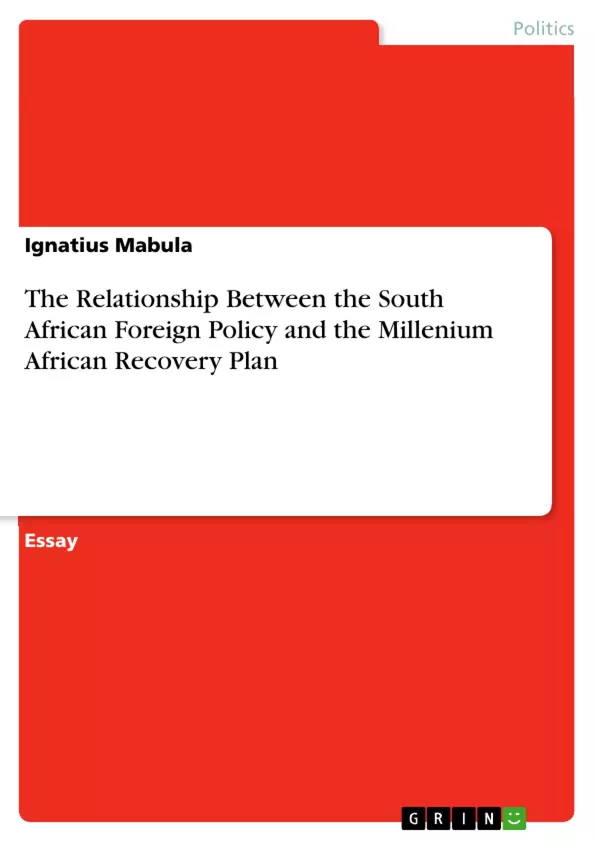The relationship between South Africa and MAP emanates from South Africa's Foreign policy which advanced: Promotion of justice, democracy and human rights as well as prosperity and security achieved through economic development. South Africa's philosophy of African Renaissance directed at rejuvenating and renewing Africa transforms the continent into an arena of peace, security and stability, was blended into MAP. Economically, South Africa's adoption of neo-liberal policies in MAP were encouraged by South Africa's incorporation of neo-liberal visions in MAP and have been influenced by the country’s adoption of Growth, Equity and Redistribution (GEAR) in 1996. GEAR became the macro-economic framework for all policies of the government whose aim was to make South Africa the preferred destination for Foreign Direct Investment (FDI) as well as allowing the country to occupy a comfortable position in the rapidly globalising world. However, MAP has been grappling with numerous challenges and its dependency underpinning. These challenges include structural, endogenous and exogenous factors which continue to constrain Africa’s endeavours.
This paper focuses on the relationship between South African foreign policy and MAP. The paper explores foundations and the evolution of South African foreign policy dating back to the apartheid foreign policy which has been perceived as pariah to the current democratic foreign policy of a middle power operating along multilateral avenues and being perceived as a pivot. Throughout the paper, the reader is afforded the opportunity to witness the operationalization of the South African foreign policy objectives; the African Renaissance, and the Millennium African Recovery Plan (MAP), which are the cornerstones of the relationship between South Africa and MAP. South Africa remains one of the progenitors of MAP which worked assiduously to promote and implement the plan throughout the continent. It is therefore imperative to scrutinise the relationship between the two.
Inhaltsverzeichnis (Table of Contents)
- Introduction
- Evolution of South African Foreign Policy
- Apartheid Era: Total Strategy
- Democratic Foreign Policy
- President Mandela's Regime: Idealism
- President Thabo Mbeki's Regime: Realism
- African Renaissance
- Millennium Partnership for African Recovery (MAP)
- Conclusion
Zielsetzung und Themenschwerpunkte (Objectives and Key Themes)
This paper explores the relationship between South Africa's foreign policy and the Millennium African Recovery Plan (MAP). It examines the evolution of South Africa's foreign policy, from the apartheid era to the democratic era, and analyzes how the country's foreign policy objectives, including the African Renaissance and MAP, have shaped its engagement with the continent.
- Evolution of South African foreign policy
- South Africa's role in the Millennium African Recovery Plan (MAP)
- The African Renaissance and its influence on South Africa's foreign policy
- Challenges facing the implementation of MAP
- The impact of South Africa's foreign policy on the African continent
Zusammenfassung der Kapitel (Chapter Summaries)
- Introduction: This chapter introduces the topic of the paper and outlines its main objectives and scope. It highlights the importance of understanding the relationship between South Africa's foreign policy and MAP, and its significance for the development of the African continent.
- Evolution of South African Foreign Policy: This chapter provides a comprehensive overview of the evolution of South African foreign policy from the apartheid era to the present. It examines the key historical events and figures that shaped South Africa's approach to foreign relations, and discusses the different foreign policy paradigms that have emerged over time.
- Apartheid Era: Total Strategy: This chapter focuses on the apartheid era foreign policy, analyzing its strategies, objectives, and impact on South Africa's relations with the international community. It explores how South Africa's foreign policy during this period was shaped by the country's domestic politics and its commitment to racial segregation.
- Democratic Foreign Policy: This chapter examines the transition to democratic foreign policy in South Africa, focusing on the key features of the new approach. It explores the ideals and principles that underpinned the democratic foreign policy, and how these have been implemented in practice.
- President Mandela's Regime: Idealism: This chapter delves into President Mandela's regime and its idealistic approach to foreign policy. It analyzes the key aspects of Mandela's vision for South Africa's role in the world, and how this vision was reflected in his foreign policy decisions.
- President Thabo Mbeki's Regime: Realism: This chapter focuses on President Thabo Mbeki's regime and its more pragmatic and realist approach to foreign policy. It examines how Mbeki's foreign policy was shaped by his understanding of the realities of international power and his emphasis on national interests.
- African Renaissance: This chapter examines the African Renaissance as a key concept in South Africa's foreign policy. It analyzes the origins and goals of the African Renaissance, and its influence on South Africa's approach to development and cooperation with other African countries.
- Millennium Partnership for African Recovery (MAP): This chapter explores the Millennium African Recovery Plan (MAP), highlighting South Africa's role in its development and implementation. It discusses the objectives and key principles of MAP, and examines its impact on the African continent.
Schlüsselwörter (Keywords)
This paper explores key themes such as South African foreign policy, the Millennium African Recovery Plan (MAP), African Renaissance, idealism, realism, neo-liberalism, development, democracy, human rights, and the challenges faced by the African continent.
- Arbeit zitieren
- Ignatius Mabula (Autor:in), 2013, The Relationship Between the South African Foreign Policy and the Millenium African Recovery Plan, München, GRIN Verlag, https://www.grin.com/document/376379



